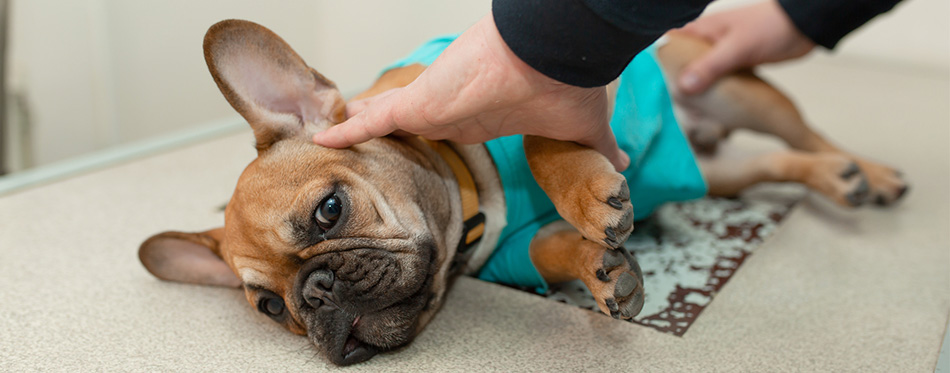We always hear from our vets and read in online pet care resources that hip dysplasia is a very common disorder found in dogs. And while there are certain breeds that are more susceptible to the development of such a health condition, the risk is forever present in all dogs. But what really is hip dysplasia and how can we best help our dogs that may have such a condition? In this article, we’ll try to address some of the concerns that many pet parents have about hip dysplasia in dogs.

A Look at Canine Hip Dysplasia
Like us humans, the hip joint is what essentially connects the dog’s hind legs to that of the rest of its body at the, well, hips. More specifically, it connects the thigh bone to the pelvis. The thigh bone or femur has an almost-spherical head which fits snuggly into a concave socket in the pelvis known as acetabulum. The surfaces of both the acetabulum and the femoral head are covered with cartilage tissues to help ensure your dog will have the widest range of motion for its hind legs while also ensuring a smoother fit.
In hip dysplasia, the normal growth and development of either the acetabulum or the femoral head is somehow affected. In most instances, the femoral head is not held tightly or deeply enough by the acetabulum. It is also possible that the surface of the acetabulum or even the femoral head is not round and smooth, causing friction as the dog moves with its hind legs. This can lead to damage of the cartilage on both surfaces.
The body will try to repair the cartilage by providing new building blocks. Unfortunately, because cartilage doesn’t have any blood vessels in it, the repair process is super slow. As such, the rate of degradation is much faster than the rate of repair. This produces inflammation and pain. More importantly, the joint is now less capable of resisting further damage. This leads to further inflammation and even greater damage.
This is the reason why we may not see signs of hip dysplasia in younger dogs. But as they grow, the combination of their body weight and their physical movements cause greater degradation of the hip joint. You may also like our article on the best dog supplements for joints.
Why Dogs Have Hip Dysplasia
We now have an idea as to how hip dysplasia occurs. The question we know you want to know now is why. Why are certain dogs like the German Shepherd, Saint Bernard, Great Dane, and Labrador Retriever more predisposed to such a condition?
Hip dysplasia has a hereditary nature. This is why certain breeds are more predisposed to its development. However, there is no conclusive evidence whether the pattern of inheritance is dominant or recessive. It is possible that because there are hundreds of different breeds out there, hip dysplasia can be either a dominant or a recessive trait depending on the breed. If it’s dominant, then you only need one parent that needs to have the trait so that the puppy will also manifest the trait. If it’s recessive, both parents of the puppy should carry the gene.
There is also new evidence that says hip dysplasia can be caused by environmental and lifestyle factors such as canine obesity, early neutering, puppy hip injuries, and repetitive movements on the still-forming joints.
What is quite interesting is that dogs that are neutered very early, well before they have reached full developmental maturity, have been shown to have double the risk of hip dysplasia than dogs that are neutered in a timely manner.
The dog’s weight is also a major risk factor in hip dysplasia. Since the acetabulum is that part of the pelvis that forms a connection with the femoral head, excessive weight pushes the acetabulum a lot closer to the femoral head. This can reduce the surface area of the connection between these two parts, increasing the risk of friction.
Faulty feeding practices have also been implicated in the development of hip dysplasia in dogs. Different breeds grow and develop at different rates. Some mature faster than others. If the dog is given more proteins, calcium, and phosphorus than absolutely necessary, this can lead to the rapid and excessive growth of the hip joint apparatus as well as other tissues. It is for this reason that hip dysplasia is no longer limited to just giant and large dogs.

How You Can Tell If Your Dog has Hip Dysplasia
If we follow the usual course of hip dysplasia progression, we know that everything depends on the impact of the risk factors we have mentioned. For instance, if the puppy suffered an injury to its hips, then it is possible that the symptoms of hip dysplasia will present much sooner. The same is true with unnecessary repetitive movements. Puppies that grow at a very fast and excessive rate can also show the manifestations of hip dysplasia much sooner than dogs that are allowed to exercise and have physical activities moderately.
Some dogs can start showing signs of canine hip dysplasia as soon as they reach 4 months old. Others can manifest the hip dysplasia symptoms when they reach old age, often in conjunction with other joint problems like arthritis or osteoarthritis.
The clinical manifestations of canine hip dysplasia are always related to their movement, especially with their hind legs. The severity of mobility impairment is dependent on the level of joint inflammation, the severity of the hip dysplasia, the degree of joint laxity or looseness, and the overall length of time that the dog has been with the condition.
While the following may also indicate other health problems, these are generally considered as indicative of a possible hip dysplasia condition in dogs.
- Decreased mobility or physical activity
- Substantial reduction in the hip joint’s range of motion
- Visible lameness of the hind legs
- Narrow stance
- Difficulty or reluctance in getting up from a lying or sitting position
- Limping while walking
- Uncoordinated gait
- Scuffing of the toe nails especially if the dog also has spinal problems
- Difficulty in or reluctant to run, jump, or climb up or down stairs
- “Bunny hop” gait
- Swaying movements especially of the hips
- Palpable reduction in the muscle mass of the thighs
- Audible grating noise from the hip joint whenever the dog moves
- Stiffness of the hips and hind legs
- Pain
- Noticeable shoulder muscle enlargement as compensatory mechanism for a weak hind leg
How I Can Be Sure If My Dog has Hip Dysplasia
While recognizing the symptoms of hip dysplasia can help, you will still need to confirm it using a number of diagnostic tests. Generally, the dog will have to undergo hip scoring test as well as . Hip scoring tests are performed at the correct age of the dog since doing it prematurely can lead to false negative results. Ideally, if you’re buying a puppy, the hip scores of both its parents should be evaluated. If the dogs are for breeding, they should also be hip scored.
X-rays of the hip joints remain an invaluable tool when it comes to establishing the presence of dysplasia while also allowing for the evaluation of the current state of the joints. Not only is the hip joint x-rayed, the backbone is also evaluated via x-ray since the soft tissues in the spine can also be negatively affected by the dysplasia in the hips. It is also possible that nerve damage is involved.
The results of the x-ray are correlated with an evaluation of the dog’s movements especially the use of its hind legs. These can include difficulty in moving or a reduction in movement as well as abnormal or unusual use of the hips or the spine.
The veterinarian is typically careful not to misdiagnose hip dysplasia as there can be other health conditions that have similar clinical presentations. These can include cauda equine syndrome, osteoarthritis dissecans, cranial crucial ligament tear, and other arthritic conditions of the rear limbs. It is imperative to rule out these health conditions so that the goal of management will be focused solely on hip dysplasia.

How Hip Dysplasia Can Be Managed
The management of hip dysplasia is dependent on the severity of the condition. If it is not too severe, then you can expect your dog to be placed on the following management regimens.
- Weight Management
Reduction in the amount of calories and fats fed can help improve the weight of the dog that has mild to moderate hip dysplasia. Controlling the weight of your dog is important so that undue pressure and strain is not continuously exerted on the already-compromised joint surfaces of the hips.
Related Post: Dog Food for Weight Loss
- Anti-inflammatory Medications
These are medications that are designed to help reduce the inflammation in the hip joint. Depending on the severity of the inflammation, your dog may receive nonsteroidal anti-inflammatory drugs or NSAIDs or even aspirin. In worse cases of joint inflammation, steroids may be needed.
- Joint Fluid Modifier Therapy
Since one of the pathologies inherent in hip dysplasia is damage to cartilage tissues which also function in the production of joint lubricant, one of the therapies that can help dogs with hip dysplasia is joint fluid modifier. It doesn’t modify anything, though. What this therapy entails is the introduction of building blocks like glucosamine and hyaluronic acid into the dog’s hip joint. While you can supplement your dog’s diet with these substances as well as chondroitin and MSM, the manner of delivery means joint fluid modifiers can immediately start working upon administration.
- Physical Therapy
Your dog may have to undergo physical therapy to help improve the range of motion of its joints while also making sure that its muscles don’t suffer from disuse syndrome. Devices may have to be designed to aid in mobility while hydrotherapy can help provide for a more efficient use of the dog’s muscles and joints without putting stress on the joints.
- Exercise Restriction
Too much movement can only exacerbate the rate of degradation and inflammation formation of the already-compromised joint. Hydrotherapy can be a good exercise for dogs with hip dysplasia.
For dogs that may have moderate to severe hip dysplasia and are deemed excellent candidates for surgery, they may undergo any of the following surgical procedures:
- Total Hip Replacement
This is perhaps the most radical, yet most effective approaches to canine hip dysplasia. As the term implies, the entire hip joint is replaced with plastic and metal implants. This can restore full hip function while also ensuring the elimination of the various discomforts related to canine hip dysplasia.
- Femoral Head Osteotomy
This procedure involves the cutting off or the removal of the head of the femur. Once the femoral head is surgically sawed off, the femur itself will try to create a new layer of tissue which will serve as the new surface that articulates with the acetabulum. This will not restore normal function of the hip. However, it can be a very effective strategy for pain management.
- Double/Triple Pelvic Osteotomy
This is indicated in younger dogs that are not older than 10 months. The surgeon selectively cuts the pelvic bone to help improve the function of the acetabulum and femoral head apparatus. The segments are rotated in such a way that their functions are enhanced.
Related Post: Dog Joint Supplements

Can Hip Dysplasia Be Prevented?
While hip dysplasia has a genetic origin which effectively eliminates any means of evading the disease, there are a number of ways by which you can somehow lower the risk of its development in your dog.
- Feed your puppy a diet that is appropriate for its growth and developmental needs without ever causing excessive growth as this can put undue strain on its still-developing hip joints.
- Give your dog appropriate forms of exercise so as not to put too much stress on the joints while also aiding in keeping its body weight within the ideal range.
- Consider supplementing your dog’s diet with glucosamine as this can help provide the building blocks for the various structures of the joints.
Hip dysplasia in dogs can be especially devastating as it hampers their ability to enjoy life. Knowing what the condition is, how it develops, and how it can be managed should give you a head start in planning the most appropriate care for your dog that’s at risk of hip dysplasia.
Sources:
- Canine Hip Dysplasia – Texas A&M University Veterinary Medical Teaching Hospital
- Hip Dysplasia In Dogs – AKC

